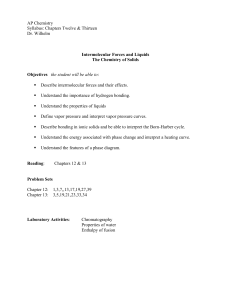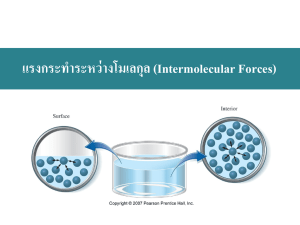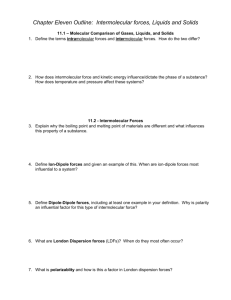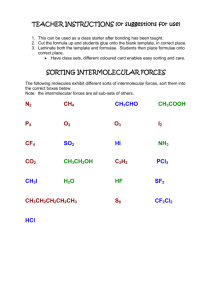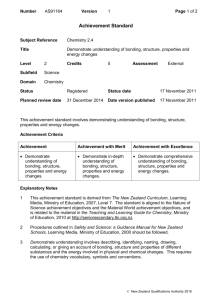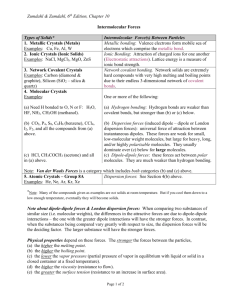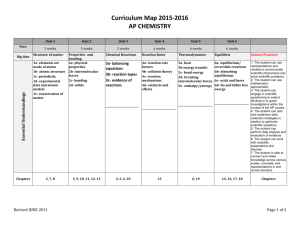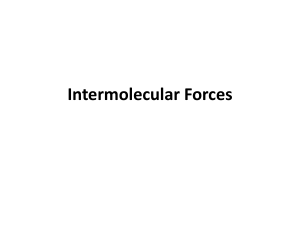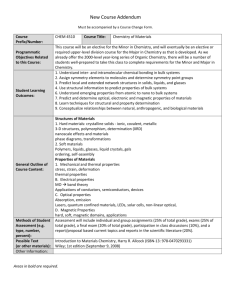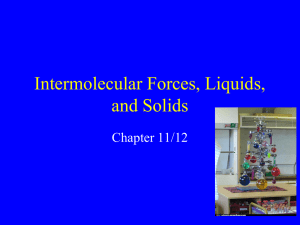AP Chemistry-chapter 12&13 (Kotz) reading guide
advertisement
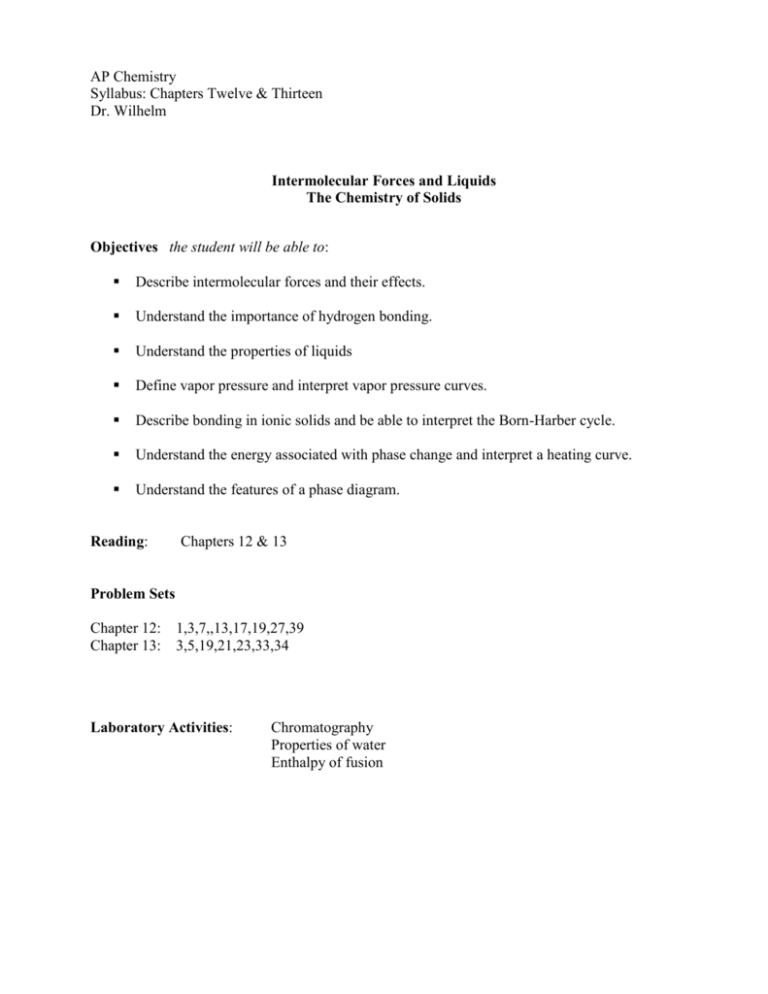
AP Chemistry Syllabus: Chapters Twelve & Thirteen Dr. Wilhelm Intermolecular Forces and Liquids The Chemistry of Solids Objectives the student will be able to: Describe intermolecular forces and their effects. Understand the importance of hydrogen bonding. Understand the properties of liquids Define vapor pressure and interpret vapor pressure curves. Describe bonding in ionic solids and be able to interpret the Born-Harber cycle. Understand the energy associated with phase change and interpret a heating curve. Understand the features of a phase diagram. Reading: Chapters 12 & 13 Problem Sets Chapter 12: Chapter 13: 1,3,7,,13,17,19,27,39 3,5,19,21,23,33,34 Laboratory Activities: Chromatography Properties of water Enthalpy of fusion AP Chemistry Dr. Wilhelm Chapter Twelve Reading Guide: Intermolecular Forces and Liquids Chapter Thirteen Reading Guide: The Chemistry of Solids On a separate piece of paper, write a response to the following reading prompts while reviewing chapter eight of your textbook. 1. Identify the three ways documented in our textbook in which intermolecular forces (IMF) influence chemistry. 2. Identify the three types of intermolecular forces that are described under the umbrella of van der Waals forces. 3. What constitutes an ion-dipole force and what factors contribute to the strength of this attractive force? Give an example of when ion-dipole attraction is applied in chemistry. 4. When do dipole-dipole forces exist? Why does a strong dipole-dipole force increase the boiling point of a polar solvent such as water? How does this also influence solubility? 5. When does hydrogen bonding occur and what is the explanation for this strong dipole-dipole? Give several examples of materials that exhibit H-bonding. 6. Specifically, describe how hydrogen bonding provides the unique properties of water. Reflect on the density of water in the solid and liquid phase and also the heat capacity of water. Why is this unique to water? What is the role of H-bonding? 7. Define dipole-induced dipole and relate the term of polarization to this concept. What factors describe a molecule’s “polarizability”? 8. Explain the phenomenon behind London Dispersion forces (induced dipole-induced dipole forces). How does this differ from dipole-induced dipole? 9. Define vaporization and condensation and identify which is endothermic and which is exothermic. Think about the role that energy plays in these state changes on a molecular level. How would the role of intermolecular forces between molecules influence the energy requirement(s)? 10. What is vapor pressure? How does vapor pressure define a substance’s volatility? Review figure 12.17 to understand how to interpret a vapor pressure curve. 11. What defines “normal boiling point”? 12. After viewing figure 12.20- go back and define the term critical point and supercritical fluid. Draw a picture of the CO2 phase diagram and identify the critical point and super critical fluid region. 13. Lastly, distinguish between the terms: surface tension and capillary action and between adhesive forces and cohesive forces. Chapter 13: The Chemistry of solids: 1. Identify the term unit cell and relate that to the concept of crystal lattice. Review figure 13.4 and draw simple pictures to distinguish the primitive cubic, body-centered cubic and face-centered cubic cell. 2. (semi-conductor technology is pretty neat but I’m afraid we don’t’ have time to address this- feel free to peruse on you r own!) 3. Describe the unique properties of an ionic compound. What is meant by the term lattice enthalpy? 4. What is the Born-Haber cycle? Review figure 13.16 and think about how this relates to past thermochemistry problems. We’ll be tackling this quantitatively! 5. Compare and contrast the following three states of solids: Molecular solid Network solid Amorphous solid 6. Define enthalpy of fusion and enthalpy of sublimation. 7. Phase diagrams: 1. 2. 3. 4. 5. 6. Sketch out a representative phase diagram: Label the x & y axis Label the three compartments as solid/liquid/gas Define phase changes across these borders ( ↔) both directions! Label the triple point and critical point. Memorize this!
